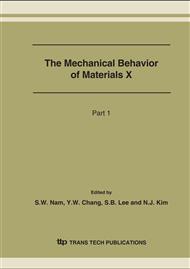p.1525
p.1529
p.1533
p.1537
p.1541
p.1545
p.1549
p.1553
p.1557
Sliding Wear Characteristics and Fabrication of LPS-SIC Ceramic by Sintering Additives
Abstract:
Silicon carbide (SiC) materials have been extensively studied for high-temperature components in fusion blanket system and gas turbines, because they have excellent a hightemperature mechanical properties, high thermal conductivity and wear resistance. However, the brittle characteristics of SiC such as low strain-to fracture still impose a severe limitation on the practical application of SiC materials. Therefore, a study of the sliding wear characteristics and fabrication of SiC ceramic by sintering temperature and additives are need. As the result of abrasion, the friction coefficient of the monolithic SiC sintered at 1800°C was the lowest, and the friction coefficient of that sintered at 1760°C was the highest. The monolithic SiC manufactured at 1800°C showed the highest hardness and the lowest friction coefficient. The friction coefficient of the monolithic SiC sintered by the SiO2 contents of 2wt% was the lowest, and the friction coefficient that sintered by the SiO2 contents of 5wt% was the highest. 1800°C of sintering temperature and 2wt% of SiO2 contents ware shown high hardness, low friction coefficient and wear loss compare with other temperatures and SiO2 contents.
Info:
Periodical:
Pages:
1541-1544
Citation:
Online since:
August 2007
Authors:
Keywords:
Price:
Сopyright:
© 2007 Trans Tech Publications Ltd. All Rights Reserved
Share:
Citation:


